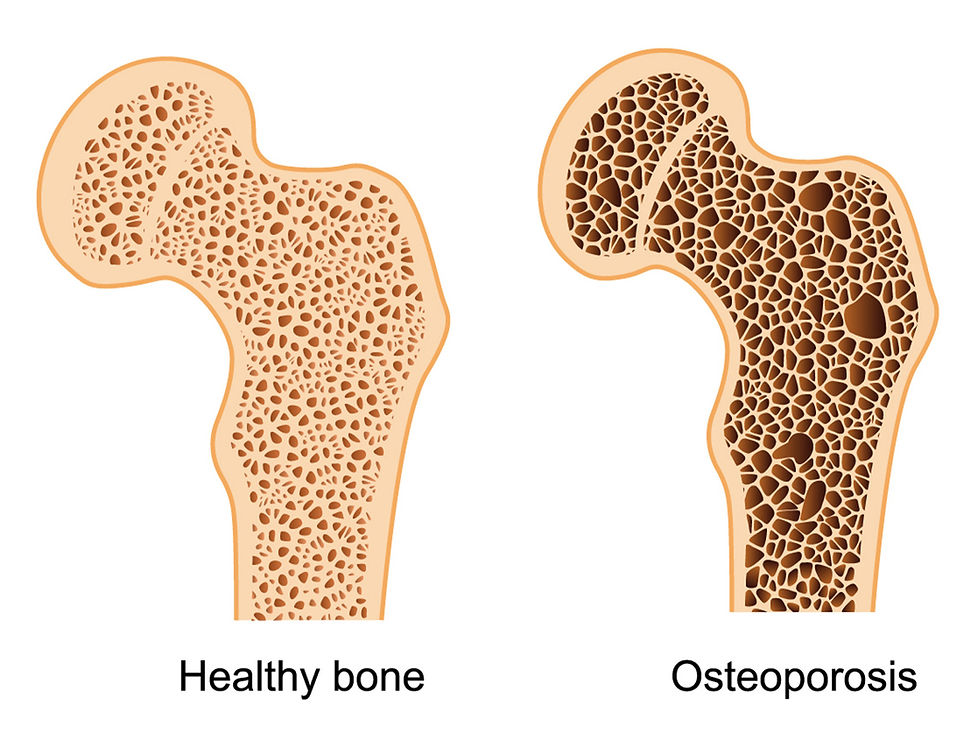Osteoporosis Prevention: How to Keep Your Bones Strong Beyond 40
- MedWords Editorial

- Aug 10
- 3 min read

When we think about aging, wrinkles or slower metabolism might come to mind first, but bone health often gets overlooked. The truth is, our bones are living tissue, constantly breaking down and rebuilding. As we age, especially after 40, this process slows, and bone loss can outpace bone formation. Left unchecked, it can lead to osteoporosis, a condition that makes bones brittle and more likely to fracture.
The good news? You can protect your bones long before trouble starts.
Understanding Osteoporosis
Osteoporosis means “porous bone.” Under a microscope, healthy bone looks like a honeycomb. In osteoporosis, the spaces inside the honeycomb grow larger, making bones weaker. It doesn’t happen overnight; it’s a silent process that can progress for years without symptoms until a fracture occurs.
Women are more likely to develop it, especially after menopause, because estrogen (a hormone that helps protect bones) drops sharply. But men aren’t immune; age, lifestyle habits, and medical conditions can all play a role.
Why Prevention Should Start Early
Bone mass peaks in your 20s and 30s, but after about age 40, bone breakdown begins to outpace bone building. While you can’t completely stop this natural decline, you can slow it significantly with the right habits. Think of it like a savings account: the more you “deposit” into your bone health early, the more you’ll have to rely on later.
Key Strategies to Keep Bones Strong
1. Get Enough Calcium - from Food First
Calcium is the building block of bones. Adults over 40 should aim for around 1,000–1,200 mg per day. Dairy products are an obvious source, but leafy greens (kale, bok choy), fortified plant-based milks, almonds, and tofu are excellent alternatives. Supplements can help if diet alone isn’t enough, but talk to your doctor before starting them.
2. Don’t Forget Vitamin D
Without vitamin D, your body can’t absorb calcium effectively. Sunlight is the most natural source; 10–20 minutes a few times a week is enough for many people. Fatty fish, fortified foods, and eggs also help. If your levels are low, your doctor may recommend supplements.
3. Prioritize Strength and Weight-Bearing Exercise
Lifting weights isn’t just for building muscle; it signals your bones to grow stronger. Activities like walking, dancing, hiking, and resistance training put healthy stress on bones, encouraging density. Even short, regular sessions make a difference.
4. Limit Bone-Damaging Habits
Smoking and excessive alcohol consumption speed up bone loss. High-sodium diets can also cause your body to lose more calcium through urine. Moderation matters, and small lifestyle tweaks add up.
5. Maintain a Healthy Weight
Being underweight increases the risk of bone loss, while being significantly overweight can strain joints. Aim for a balanced diet and an active lifestyle to keep your weight in a healthy range.
When to Get Checked
If you have a family history of osteoporosis, have had fractures after minor falls, or have medical conditions that affect hormones or nutrient absorption, ask your doctor about a bone density scan (DEXA). This test can detect bone loss early and guide prevention strategies.
Small Daily Habits That Pay Off Big
• Add a handful of almonds or seeds to snacks.
• Take the stairs instead of the elevator.
• Do bodyweight exercises like squats or push-ups at home.
• Get outside for sunlight and a quick walk.
• Replace sugary sodas with calcium-rich smoothies or fortified drinks.
The Bottom Line
Osteoporosis doesn’t have to be an inevitable part of aging. By focusing on nutrient-rich foods, regular exercise, and bone-friendly habits now, you can keep your skeleton strong well into your later years. Prevention isn’t about perfection; it’s about consistent choices that protect you for decades to come.
Comments